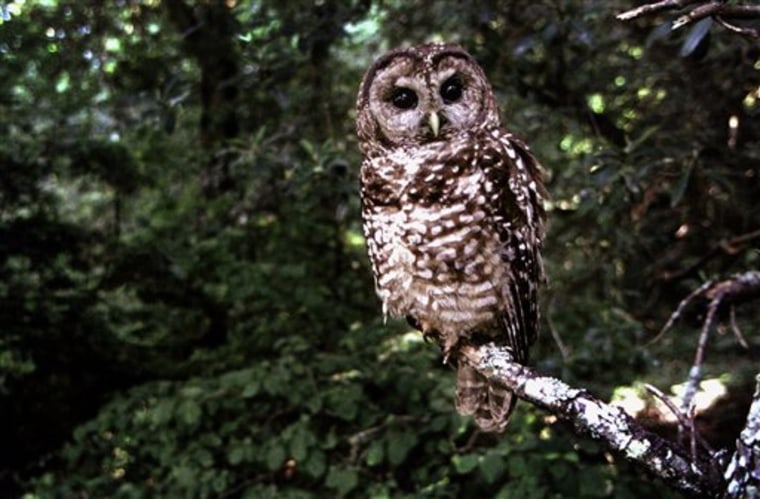The Obama administration on Thursday scrapped the Bush administration's last-ditch attempt to boost logging in Northwest forests by scaling back protection for the northern spotted owl.
Interior Secretary Ken Salazar said Thursday that a plan to increase logging on federal lands in western Oregon could not stand up to challenges under the Endangered Species Act. He said the Department of Interior would develop new measures protecting the spotted owl.
The Bush administration had cut the size of critical habitat for the owl and revised the spotted owl recovery plan to make the logging increases possible.
The Western Oregon Plan Revision was created to increase logging on millions of acres of U.S. Bureau of Land Management lands and boost federal revenues shared with timber counties. The plan was five years in the making, but was only completed in the final days of President George W. Bush's administration.
To make the deadline, BLM argued that it did not have to consult with federal biologists over the potential harm to spotted owls and salmon, and would do that on individual timber sales as they were offered. Salazar said their review determined that argument would never withstand a court challenge.
"Bush administration actions doomed the plan," Salazar told reporters on a teleconference from Washington, D.C. "Now, at a time when western Oregon communities are already struggling, we face the fallout of the previous administration's skirting of the law and efforts to taint scientific outcomes."
Salazar noted repeatedly that an inspector general's report last year found former Interior deputy secretary Julie MacDonald had manipulated scientific findings on protections for the spotted owl.
Decisions on offering timber sales will once again be governed by the Northwest Forest Plan, and Interior will work to expedite timber sales that are not likely to be challenged under environmental laws, Salazar added.
Bush's logging plan would have allowed five times the timber harvest sold last year. While a big jump, it would have been just half of what was logged before the 1994 Northwest Forest Plan dramatically cut logging to protect habitat for owls and salmon.
Lawsuits from conservation groups sparked the Northwest Forest Plan, which cut logging by more than 80 percent in national forests of Oregon, Washington and Northern California to protect habitat for the spotted owl and salmon.
To settle a challenge to the Northwest Forest Plan by the timber industry, the Bush administration agreed to produce a new spotted owl recovery plan, review the critical habitat designation, and develop the Western Oregon Plan Revision.
The new spotted owl recovery plan, completed last year, argued that wildfire and the barred owl, an aggressive eastern species pushing spotted owls out of their territory, were greater threats to the spotted owl than logging.
That made room for BLM to increase logging, particularly in areas set aside for wildlife habitat under the Northwest Forest Plan.
Andy Stahl, director of Forest Service Employees for Environmental Ethics, said Thursday's decision reverses Bush's "backward step in protection of Oregon fish and wildlife habitat." Stahl is a plaintiff in one of the lawsuits challenging the BLM's Western Oregon Plan Revision.
"This restores the situation before Bush embarked upon this silly exercise," he said.
Tom Partin, president of the timber industry group American Forest Resource Council, said they hoped to build amount of timber allowed under the Northwest Forest Plan, and were encouraged by Salazar saying they would work to turn out timber sales that would not be challenged by environmentalists, particularly in southwestern Oregon where the timber economy has been hard-hit.
Shortly before the announcement, acting Assistant Interior Sec. Ned Farquar told a conference call of attorneys that Interior was withdrawing the Western Oregon Plan Revision and seeking dismissal of four lawsuits challenging it — three from conservation groups and one from the timber industry.
In a related development, a new study challenges a basic justification about the threat of wildfires that the Bush administration used to make room for more logging in old growth forests that are home to the northern spotted owl.
The study, appearing in the journal Conservation Biology, found no increasing threat of severe wildfires destroying old growth forests in the drier areas where the owl lives in Oregon, Washington and Northern California.
"The argument used to justify a massive increase in logging under the (spotted owl) recovery program was not based on sound science," said Chad Hanson, a fire and forest ecologist at the University of California, Davis, who was lead author of the study. "The recovery plan took a leap-before-you-look approach and did it without sound data."
The study took satellite imagery on fire severity from 1984-2005, and compared it with government data identifying old growth forests on the east side of the Cascades in Oregon, Washington and California, and the Klamath Mountains of southern Oregon and California — all identified in the recovery plan as having the highest fire danger.
The rate of high-severity wildfires in old growth was 1.34 percent on the east side of the Cascades, and 1.74 percent in the Klamath Mountains, the study found. That amounts to a high-severity fire burning a given piece of old growth forest every 746 years on the east side of the Cascades, and every 575 years in the Klamaths.
The recovery plan looked at smaller portions of the landscape than the study and shorter periods of time, and extrapolated those results to reach its conclusions, Hanson said.
"The existing (Bush-era) recovery plan is so clearly based on these incorrect assumptions that you can't just tweak it here and amend it here and fix it," Hanson said.
Forests are actually maturing into old growth suitable for owl habitat five to 14 times faster than they are being burned by wildfire, added co-author Dominic DellaSala, chief scientist for the National Center for Conservation Science & Policy and a member of the spotted owl recovery team that fought with the Bush administration over the owl recovery plan.
